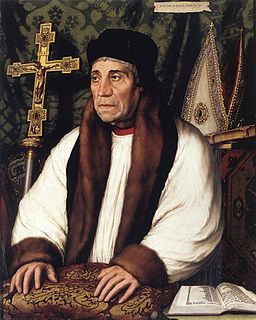
The House of Tudor was an English royal house of Welsh origin, descended from the Tudors of Penmynydd. Tudor monarchs ruled the Kingdom of England and its realms, including their ancestral Wales and the Lordship of Ireland from 1485 until 1603, with five monarchs in that period: Henry VII, Henry VIII, Edward VI, Mary I and Elizabeth I.. The Tudors succeeded the House of Plantagenet as rulers of the Kingdom of England, and were succeeded by the House of Stuart. The first Tudor monarch, Henry VII of England, descended through his mother from a legitimised branch of the English royal House of Lancaster. The Tudor family rose to power in the wake of the Wars of the Roses (1455-1487), which left the House of Lancaster, with which the Tudors were aligned, extinct in the male line.

Thomas Grey, 1st Marquess of Dorset, 1st Earl of Huntingdon, 7th Baron Ferrers of Groby, was an English nobleman, courtier and the eldest son of Elizabeth Woodville and her first husband Sir John Grey of Groby. Her second marriage to King Edward IV made her Queen of England, thus elevating Grey's status at court and in the realm as the stepson of the King. Through his mother's assiduous endeavours, he made two materially advantageous marriages to wealthy heiresses, the King's niece Anne Holland and Cecily Bonville, 7th Baroness Harington. By the latter he had 14 children.
Thomas Ruthall was an English churchman, administrator and diplomat. He was a leading councillor of Henry VIII of England.
Events from the year 1622 in England.
Events from the 1530s in England.
Events from the 1420s in England.
Events from the 1450s in England.
Events from the year 1456 in England.
Events from the year 1457 in England.
Events from the year 1459 in England.
Events from the 1480s in England. This decade marks the beginning of the Tudor period.
Events from the 1490s in England.
Events from the 1500s in England.
Events from the year 1504 in England.
Events from the year 1505 in England.
Events from the year 1506 in England.
Events from the 1510s in England.
Events from the 1520s in England.
Events from the 1150s in England.








